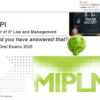Shaping IP for Advantage: Insights from Nordic IP Day at Maersk HQ
The Nordic IP Day at Maersk Headquarters in Copenhagen brought together practitioners who shape how innovation becomes value. More than 130 participants representing over 90 companies from the Nordics and beyond joined the event, underlining the importance of intellectual property as a shared concern across industries and geographies. My session explored the ambivalence of IP — how it can both accelerate progress and, if poorly designed or executed, slow it down. But the heart of our program was a set of expert contributions that translated strategy into practice. Below is a synthesis of the key takeaways, with a special focus on five IP Subject Matter Experts whose work turns principles into results.
Setting the Stage: Why IP Still Matters in 2025
Innovation today is a coordination challenge as much as a creativity challenge. Companies compete on architectures, interfaces, data, user experience, and supply chain resilience. In this landscape, IP is not merely legal protection; it is a governance system for collaboration and competition. When used thoughtfully, it underwrites investment, enables partnerships, and sets the rules of engagement across ecosystems. When neglected, it invites cost, conflict, and strategic drift. That tension framed our discussion and connected directly to the expert cases that followed.
Keynote: Freeing Innovation Without Losing the Rules
The central question I posed was simple: if we could redesign IP from scratch, would we keep it—and in what form? Historically, IP has been defended as a catalyst for investment and criticized as a barrier to access. In the digital, data‑intensive economy, those arguments have intensified. The way forward is not ideological, but architectural: treat IP as a design space. Choose mechanisms—patents, trade secrets, designs, copyright, licenses—that align with the business model, the community around the product, and the societal context. Do not ask whether IP is good or bad in the abstract; ask whether a specific configuration of rights, obligations, and processes supports participation, interoperability, and fair value capture.
From Principles to Practice: Five Expert Lenses
What matters to executives is not the doctrine but the decisions. The five expert perspectives in my session offered clear operating models that leaders can apply immediately. Together they show how to sustain advantages, run operations, systematize processes, protect the look and feel of products, and enforce secrecy in a world of fluid teams and rapid iteration.
Sascha Kamhuber — Turning Patent Intelligence into Strategic Leverage
Sascha Kamhuber’s contribution went beyond claim drafting theory: he drew on his work deploying patent information as a decision engine, particularly visible in engineering-driven sectors like the steel industry. Drawing on insights from his 🔗dIPlex contribution on patent information in the steel industry, he explained how patent analytics can be embedded into product development and strategic oversight, turning data into foresight.
He emphasized three guiding principles:
- Patent intelligence as early warning and opportunity scanner: Continuous monitoring of patent landscapes should shape R&D direction and strategic choices. In steel, for example, this means spotting clusters around energy efficiency, alloys, or digital control systems. Rather than waiting for filings, companies can steer earlier and avoid redundant research.
- Aligning claims with ecosystem constraints: Start from the constraints that define buyer switching costs—performance limits, input ratios, interface standards—and work backward to target inventions that matter most. In practice, claims must bind those constraints, whether in steel processing, energy efficiency, or integration architectures.
- Marrying evidence, metrics, and narrative: Portfolios become persuasive when they rest on an empirical story. Benchmark data, failure deltas, and comparative performance evidence strengthen prosecution and licensing. R&D truth, when documented and communicated, becomes legal leverage and accelerates agreement.
The practical upshot: portfolios must be seen as a living, data-infused input into engineering decisions and competitive posture. Kamhubers perspective challenged the audience to see patents not as static legal artifacts but as maps of influence and technology trajectories.
Per Wendin — Embedding IP Operations into Organizational Rhythms
Per Wendin’s contribution drew heavily from his 🔗dIPlex framework for Operational IP Management, emphasizing that IP is not a legal afterthought but a continuous operational discipline. He challenged the idea that IP lives in a vault — instead, it must be woven into everyday processes across R&D, product, legal, and business teams.
Wendin’s version of operational rigor rests on four pillars:
- Integrated workflows over handoffs: Rather than throwing ideas over the wall from R&D to legal, he urged embedding IP triggers into development sprints, design reviews, and architecture gating. This ensures that invention capture, protectability checks, and claim brainstorming happen as natural steps, not delayed interventions.
- A living IP register as single source of truth: He underscored the need for a dynamic inventory of all invention disclosures, patent families, licensing obligations, and dependencies. The register should be more than a spreadsheet — it must reflect linkages to product roadmaps, market launches, partner contributions, and renewal schedules.
- Strategic portfolio operations: Wendin extended the concept of portfolio hygiene into operational discipline: periodic pruning, reclassification, and realignment based on performance metrics (citation patterns, licensing traction, product impact). He described investing in assets that map to commercial leverage and letting go of legacy patents without strategic relevance, mirroring his view of portfolios as dynamic, not static.
- Alerting, compliance, and continuous alignment: He advocated integrating automated docketing, trigger alerts for collaboration clauses or territorial duties, and real‑time alignment checks between IP status and market plans. When these operational checks fail, IP becomes reactive and costly — Wendin’s insistence is that well‑oiled routines prevent surprises.
Wendin’s closing message: operational excellence is not bureaucratic friction; it is the mechanism that transforms strategy into execution. When these programs run smoothly, legal advice becomes forward‑looking rather than remedial, and leadership gains confidence in scaling innovation without litigious drag.
Max Feucker — Structuring IP Flow as a Competitive Asset
Where Per Wendin builds the routines and Sascha shapes strategic direction, Max Feucker’s contribution focuses on process as the infrastructure that keeps IP energy flowing rather than clogging. Drawing from his 🔗dIPlex work on IP Process Management, Max argues that the unseen tax on innovation is weak or fragmented IP process design—and his methods aim to turn that tax into leverage.
Feucker’s framework centers on four core design principles:
- Canonical process mapping with minimal variants: Instead of managing countless ad hoc paths, Max recommends defining the ~7–10 core process flows (for example: invention to filing, licensing contribution, background/foreground split in joint projects, design registration, trade secret onboarding). This abstraction reduces complexity, ensures consistent training, and helps audits, without losing flexibility.
- Decision gates driven by evidence bundles (not opinions): At each gate—file, continue, pivot, or abandon—the team must supply minimal but structured evidence: prior-art snapshots, benchmarking comparisons, business impact assessments, or technical test results. This makes each decision auditable, explainable, and, if needed, reversible.
- Feedback loops and pattern learning: Feucker stresses that process design must embed learning: after grant, rejection, opposition, or litigation, teams must feed lessons back into templates, search heuristics, and drafting practices. Over time, this reduces rework and improves first-pass quality.
- Flow metrics, not volume metrics: The key signals are lead times (disclosure → first action), rework rates (office action cycles), scope erosion (difference between filed claim scope and granted scope), and the ratio of filings to commercial milestones achieved. These tell you if the system is healthy—or if you’re just generating filings without business impact.
Feucker contrasted his approach to traditional “count‑the‑patents” metrics. The latter rewards volume and encourages low‑value filings; his “flow metrics” reward precision, speed, and alignment to business value.
His vision: a process architecture that doesn’t merely support IP but leverages IP as a real-time input to product planning, commercialization decisions, and ecosystem engagement. In doing so, Max invites us to treat process as a competitive asset rather than just internal plumbing.
Malgorzata Zyla — Designing Rights Around Visual Distinctiveness
In markets driven by brand perception and product experience, aesthetics and user interface matter as much as performance. Drawing on her 🔗dIPlex work on design rights and visual innovation, Malgorzata Zyla laid out how organizations can build layered protection around the visuals that shape identity, usability, and emotional appeal.
Her approach unfolds in four complementary strategies:
- Distil the signature visual DNA: Start from the gestalt — the minimal, distinguishing set of shapes, proportions, surface textures, lighting effects, and transitions that make a product uniquely recognizable. Zyla recommends creating a core design language, along with valid variants, so that future refreshes remain covered by protection. This “design core” becomes the anchor of subsequent enforcement and licensing.
- Protect interaction surfaces and micro-moments: It’s not just static form: the user journey across screens, visual feedback cues, animation states, confirmation flows, even notification icons—these micro-interfaces influence perception and behaviour. Where design rights might not reach, Zyla suggests layering in UI/UX protection regimes, collective rights, or contractual constraints to surround those interaction facets.
- Combine design and utility in hybrid claims: Some visual features stem from functional innovation—cooling patterns, sensor cover geometries, glare reduction meshes. In these cases, Zyla’s method is to pair design protection with narrowly tailored utility claims on the underlying mechanism, creating a hybrid protection barrier that blocks both aesthetic knock-offs and functional equivalents.
- Enforce through behavioural evidence and market context: In crowded product categories, a visual imitation may seem innocuous absent real evidence of confusion. Zyla emphasizes collecting user journey analytics, comparative browsing data, side-by-side image testing, and consumer testimony. This empirical narrative helps courts or arbitrators see why a copy misleads. She also recommends watermarking, version logs, and design archives to show priority and variation control.
Zyla’s message to product and IP leaders: if the “look and feel” of your product does economic work—by driving trust, brand, or usability—it deserves the same rigor in protection as your core technical features. Visual innovation is not decoration; it is strategic architecture.
Axel Oldekop — Litigation of Trade Secrets
Trade secrets sit at the junction of speed, value, and vulnerability. Drawing on his 🔗dIPlex contribution on the litigation of trade secrets, Axel Oldekop showed how effective management and litigation strategy are inseparable.
His perspective emphasizes that litigation outcomes depend less on courtroom tactics than on the preparation and governance that precede disputes. His framework included:
- Define and classify: Establish a living inventory of know-how, trade secrets, and confidential business information, each with ownership, access controls, and expiry/review dates. Without classification, enforcement becomes guesswork.
- Build contractual armor: NDAs, employment agreements, and collaboration contracts must clearly stipulate permitted use, residual knowledge limits, post-termination obligations, and jurisdiction. These agreements must also travel with assets in carve-outs, spin-offs, and acquisitions.
- Demonstrate reasonable measures: Courts look for proof that a company actually treated information as secret. Oldekop pointed to logs, watermarks, restricted access, and training as evidence, but also stressed cultural indicators such as executive attestations that demonstrate care across the organization.
- Prepare the evidentiary chain: Winning cases often hinge on the ability to present a clear, time-stamped narrative of how information was created, who had access, and when protective measures were applied. Version histories, onboarding/offboarding documentation, and repository policies all build this chain.
The cultural insight behind his contribution is simple but powerful: companies that normalize secrecy discipline across all functions face fewer breaches and, when disputes do occur, they secure injunctions faster and negotiate settlements from a stronger position.
Connecting the Dots: An Operating System for Advantage
Viewed together, the five contributions form a coherent operating system:
- Strategy: Kamhuber’s outside‑in claim design ensures protection is aimed at the levers that matter.
- Operations: Wendin’s routines keep decisions quick, evidence‑based, and auditable.
- Processes: Feucker’s architecture removes friction and compounds learning.
- Expression: Zyla’s approach ensures the visual dimension of value is owned, not just admired.
- Integrity: Oldekop’s playbook preserves the knowledge that cannot be patented but defines execution.
This operating system is modular. Each part elevates the others, and the full stack is adaptable to sector specifics—from regulated life sciences to high‑velocity consumer electronics.
What Leaders Should Do Next
First, realign your patenting to the market’s switching logic. Audit the last ten competitive wins and losses; extract the concrete reasons buyers moved or stayed. Use that to retarget claim drafting for the next cycle. Second, build the weekly and quarterly routines that keep the system honest. There is no strategy strong enough to survive unmanaged variability in disclosure quality, counsel instructions, or renewal decisions. Third, surface and protect the visual dimension of your product strategy. If design cues earn trust or shape behaviour, they belong in your rights architecture. Fourth, refresh your secrecy discipline for a world of hybrid work, code reuse, and fluid collaboration. Finally, measure flow. Lead time and rework rates will tell you more about future IP quality than any count of filings.
Nordic Context: Why This Matters Here
Nordic companies compete globally with a distinctive blend of engineering rigor, sustainability focus, and human‑centered design. That combination sets a high bar for IP management. Portfolios must support interoperability in ecosystems, yet be strong enough to command licensing respect. Operational routines must be lean and people‑centered to match smaller, high‑skill teams. Processes must reflect collaborative culture without compromising on evidentiary rigor. Visual innovation is part of the brand promise and needs a matching protection approach. And secrecy management must fit distributed, trust‑based organizations without naivety about risk.
The good news is that these strengths compound. When rights are sequenced to the business model, operations are clean, and evidence flows, Nordic firms can scale their influence far beyond their headcount.
Closing Reflection
The enduring truth in IP is ambivalence: the same mechanisms that enable investment can, if misapplied, hinder access and slow diffusion. The answer is not to abandon the tools but to configure them like a well‑designed system. The expert perspectives shared in Copenhagen show how to do that work—precisely, repeatedly, and in ways that let technology, partnerships, and customer experience reinforce each other. That is how innovation becomes advantage, and advantage becomes resilient growth.
Slides from my talk are included below for those who want to study the frameworks and routings in more depth:



